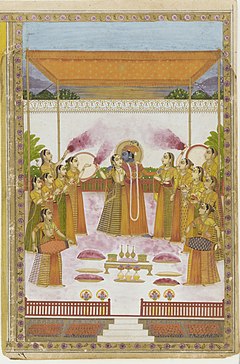
Back Holi Afrikaans होली ANP هولي Arabic ফাকুৱা Assamese फगुवा AWA Холи Bulgarian होली Bihari দোলযাত্রা Bengali/Bangla Holi Catalan ھۆلی CKB
| Holi | |
|---|---|
 | |
| Observed by | Hindus,[1] Jains,[2][3] and others[4] |
| Type | Religious, cultural, spring festival |
| Significance |
|
| Celebrations | Night before Holi: Holika Dahan or Kama Dahan On Holi: Playing with coloured powder and water, dancing, greetings, festival delicacies[5] |
| Date | Phalguna Purnima |
| 2025 date | 14 March in India[6] 24 March in Nepal (hilly region) 25 March in Nepal (terai region)[7][8] 24 March in Nepal[9] |
| Frequency | Annual |
| Related to | Hola Mohalla, Shigmo and Yaosang |
Hindu festival dates The Hindu calendar is lunisolar but most festival dates are specified using the lunar portion of the calendar. A lunar day is uniquely identified by three calendar elements: māsa (lunar month), pakṣa (lunar fortnight) and tithi (lunar day). Furthermore, when specifying the masa, one of two traditions are applicable, viz. amānta / pūrṇimānta. If a festival falls in the waning phase of the moon, these two traditions identify the same lunar day as falling in two different (but successive) masa. A lunar year is shorter than a solar year by about eleven days. As a result, most Hindu festivals occur on different days in successive years on the Gregorian calendar. | |
| Part of a series on |
| Hinduism |
|---|
 |
Holi (Hindi pronunciation: ['hoːli:]) is a popular and significant Hindu festival celebrated as the Festival of Colours, Love, and Spring.[1][10][11][12] It celebrates the eternal and divine love of the deities Radha and Krishna.[13][14] Additionally, the day signifies the triumph of good over evil,[15][16] as it commemorates the victory of Vishnu as Narasimha over Hiranyakashipu.[17][18] Holi originated and is predominantly celebrated in the Indian subcontinent of India and Nepal, but has also spread to other regions of Asia and parts of the Western world through the Indian diaspora.[11][19][20][21][22][23][24][25]
Holi also celebrates the arrival of Spring in India and Nepal, the end of winter, and the blossoming of love.[19][26] It is also an invocation for a good spring harvest season.[19][26] It lasts for a night and a day, starting on the evening of the Purnima (full moon day) falling on the Hindu calendar month of Phalguna, which falls around the middle of March in the Gregorian calendar.
- ^ a b The New Oxford Dictionary of English (1998) ISBN 0-19-861263-X p. 874 "Holi /'həʊli:/ noun a Hindu spring festival ...".
- ^ Cite error: The named reference
wiley42was invoked but never defined (see the help page). - ^ Cite error: The named reference
bal269was invoked but never defined (see the help page). - ^ Cite error: The named reference
wpnonhinduswas invoked but never defined (see the help page). - ^ Cite error: The named reference
htwas invoked but never defined (see the help page). - ^ "Holi 2025: साल 2025 में कब है होली, पूर्णिमा तिथि साल 2025 में भी दो दिन". Hindustan (in Hindi). 21 March 2024. Retrieved 25 April 2024.
- ^ "Holi 2024 Date: When is Holi and Holika Dahan this year, know the Muhurta and its importance". Financialexpress. 16 March 2022. Retrieved 16 March 2022.
- ^ "Holi 2022: Know The Date, Time, Significance And History Of The Festival". NDTV. 16 March 2022. Retrieved 16 March 2022.
- ^ "Nepal festival calendar: 15 major festivals of Nepal in 12 months every year - OnlineKhabar English News". Online Khabar. 1 May 2021. Retrieved 16 March 2022.
- ^ "What is Holi?". BBC Bitesize. Retrieved 18 March 2022.
- ^ a b Yudit Greenberg, Encyclopedia of Love in World Religions, Volume 1, ISBN 978-1851099801, p. 212
- ^ McKim Marriott (2006). John Stratton Hawley and Vasudha Narayanan (ed.). The Life of Hinduism. University of California Press. p. 102. ISBN 978-0-520-24914-1., Quote: "Holi, he said with a beatific sigh, is the Festival of Love!"
- ^ Schwartz, Susan L. (6 October 2004). Rasa: Performing the Divine in India. Columbia University Press. p. 100. ISBN 978-0-231-13145-2.
- ^ R Deepta, A.K. Ramanujan's ‘Mythologies’ Poems: An Analysis, Points of View, Volume XIV, Number 1, Summer 2007, pp. 74–81
- ^ What Is Hinduism?. Himalayan Academy Publications. 2007. p. 230. ISBN 978-1-934145-27-2.
- ^ "Festivals for Spring: Holi and Basant Kite Festival: Holi".
Holi celebrates love, forgiveness, and triumph of good over evil
- ^ David N. Lorenzen (1996). Praises to a Formless God: Nirguni Texts from North India. State University of New York Press. pp. 22–31. ISBN 978-0-7914-2805-4.
- ^ Vittorio Roveda (2005). Images of the Gods: Khmer Mythology in Cambodia, Thailand and Laos. River Books. p. 70. ISBN 978-974-9863-03-9.;
Sunil Kothari; Avinash Pasricha (2001). Kuchipudi. Abhinav. pp. 66–67. ISBN 978-81-7017-359-5. - ^ a b c Ebeling, Karin (10), Holi, an Indian Festival, and its Reflection in English Media; Die Ordnung des Standard und die Differenzierung der Diskurse: Akten des 41. Linguistischen Kolloquiums in Mannheim 2006, 1, 107, ISBN 978-3631599174
- ^ Amber Wilson (2004). Jamaica: The people. Crabtree Publishing Company. p. 18. ISBN 978-0-7787-9331-1.
- ^ Cite error: The named reference
wsj-holifightwas invoked but never defined (see the help page). - ^ Holi Festivals Spread Far From India The Wall Street Journal (2013)
- ^ Holi Festival of Colours Visit Berlin, Germany (2012)
- ^ Holi 2023 Date, Rituals, and Significance
- ^ Holi Hindu Festival
- ^ a b Wendy Doniger (Editor), Merriam-Webster's Encyclopedia of World Religions, 2000, ISBN 978-0877790440, Merriam-Webster, p. 455
© MMXXIII Rich X Search. We shall prevail. All rights reserved. Rich X Search